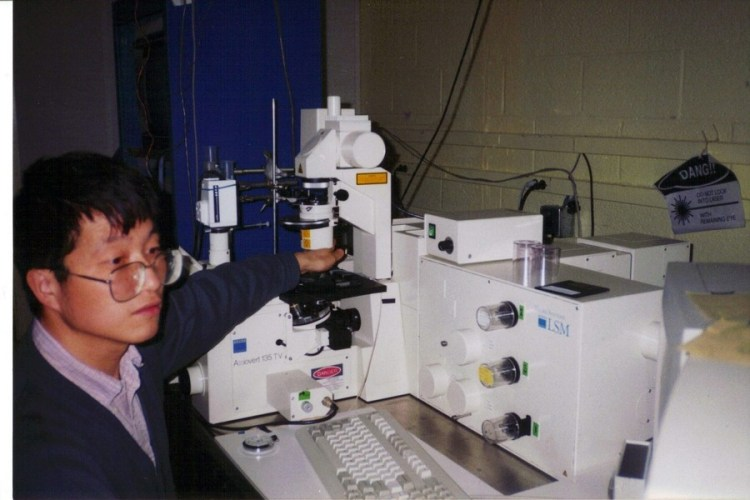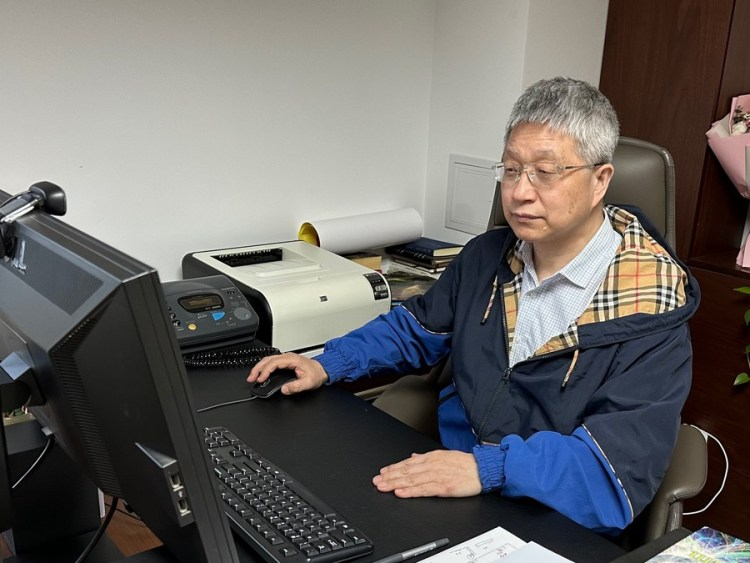This undated file photo provided by the interviewee shows Cheng Heping, a leading Chinese biomedical expert, and two of his doctoral students conducting experiments in a laboratory at Peking University in Beijing, capital of China, in 2011. (Xinhua)
BEIJING, March 28 (Xinhua) -- Cheng Heping, a leading Chinese biomedical expert at Peking University, had long hoped to create a microscope capable of recording the tiniest changes in the brains of living animals.
"How to create a microscope that can see the dynamic changes of individual neurons under the condition of small animals walking freely, this is a dream hidden in my heart," he said.
Cheng, 60, has now realized his long-standing goal. A miniature three-photon microscope recently developed by his team has achieved stable deep-brain imaging in freely moving mice. This revolutionary tool promises to reveal the mysteries of the whole human brain.
An academician of the Chinese Academy of Sciences, Cheng has spent decades researching multiphoton microscopy, and his life story is that of a growing focus on the science of photons, tiny subatomic energetic particles that he views as magical.
CLOSER TO PHOTONS
Born in a village in east China's Anhui Province in 1963, Cheng thought he was destined to become a farmer in the rice paddy fields, like his mother and grandparents. However, he showed an enthusiasm for reading, although books were a precious rarity for his family.
"I would travel long hours just to borrow a book and devour it while walking back home," Cheng recalled.
He remembers clearly his weekly happy hour following the arrival of the children's newspaper, which his parents managed to provide despite their overwhelming poverty.
In 1980, Cheng entered Peking University, where he spent nine years majoring in mechanics and biological engineering. He also received a second degree in physiology. He attributes part of his later success to this interdisciplinary background.
"In my master's thesis research, I was fascinated by the beauty of the cell for the first time when I found the double-concave shape of red blood cells optimal for transmembrane transport," said Cheng. At the time, he did not anticipate that this would inspire his future studies of cell activities using photons.
Later, he got the opportunity to study for a doctorate in physiology at the University of Maryland in the United States. He, along with his mentor and his colleague there, discovered calcium sparks in rat myocardial cells, causing a sensation at the time.
The discovery was made with a self-modified confocal laser scanning microscope, which worked in a similar way to a two-photon microscope.
A fluorescence imaging technique, two-photon microscopy allows imaging in deep living tissues. It works better than conventional fluorescence microscopy due to the characteristics of two-photon excitation, such as longer wavelength, less scattering and stronger penetrability.
From this point on, Cheng was increasingly drawn to the study of photons, which seemed to be an area with great potential.
"In the 1990s, studies of electricity had a great impact on biology, but the potential of light within life sciences had not yet been realized," he said.
This undated file photo provided by the interviewee shows Cheng Heping, now a leading Chinese biomedical expert, operating a confocal microscope in a research lab in Maryland, the United States, back in 1995. (Xinhua)
SMALLER MICROSCOPES
In 1992, during a visit to Cornell University, Cheng saw a two-photon microscope for the first time. It was only the second such device in the world.
"I was shocked by the microscope, which was the size of the whole room," he recalled.
In 2013, China's national natural science foundation started soliciting applications for the development of major national scientific research equipment. Cheng proposed to make a miniature two-photon microscope that is wearable on the head of freely moving animals for brain imaging. His proposal received a research and development fund of 72 million yuan (about 10.48 million U.S. dollars).
"Other projects applied for developing big ones, even the size of a building, while I promised a finished product weighing only 15 grams," he recalled.
However, at that time, many research teams worldwide had tried with only very limited success in building such a miniature multiphoton microscope. He and his team went to a renowned U.S. university for advice, but he was told that it was impossible to make such a tiny device.
The biggest challenge for the development of such equipment was to combine the advantages of performance and weight, with the miniature two-photon microscope having the same high resolution as a conventional one weighing tens of kilograms.
Cheng came up with the idea of shrinking the microscope's imaging parts into a thumb-sized headpiece by using devices including miniature optics, among others.
By 2017, his team had made great strides, successfully developing their first generation of miniature two-photon microscopes weighing 2.2 grams, much smaller than the 15 grams he had promised.
The smallest and lightest such device in the world at that time, it obtained dynamic images of neuronal and synaptic activities in the cerebral cortex of freely moving mice, bringing Cheng to the global forefront of brain imaging.
After four years, an upgraded two-photon microscope built by his team enlarged the imaging field by 7.8 times and featured an additional function of three-dimensional imaging.
Cheng explained the additional function as like "cutting" skin with a thickness of more than 100 microns into 100 layers. "This thickness is the same as the diameter of a human hair," he said.
Cheng Heping, a leading Chinese biomedical expert, is pictured at work in his office at Peking University in Beijing, capital of China, March 15, 2023. (Xinhua/Che Yunlong)
DEEPER INTO THE BRAIN
Cheng is determined to see deeper into the brains of mice, including viewing their entire brains, using photons.
At the end of February, his team made a new breakthrough, completing the development of a 2.17-gram three-photon microscope, which achieved stable imaging of the brain cortex and hippocampal neurons of freely moving mice at a depth of up to 1.2 millimeters. It was the first time non-invasive images of the hippocampus of freely moving mice had been captured.
The mouse brain is six millimeters deep, said Cheng, adding that the brain can be completely observed when the imaging depth reaches three millimeters, which is his future goal.
"We hope to understand brain diseases, such as Alzheimer's disease and sleep disorders, as well as their treatment strategies by dynamically observing the brains of mice during their movement and sleep," he said.
However, after solving the problems of imaging depth, other questions began to linger in his mind. Will vital signs change in weightless conditions? How will cell metabolism work in deep space?
To find the answers, Cheng, leading a joint research team supported by the China Manned Space Agency, sent the hand-held version of his 2.2-gram two-photon microscope to the country's space station onboard the Tianzhou-5 cargo craft.
Last month, the microscope successfully obtained three-dimensional structural images of skin cells from the Chinese Shenzhou-15 astronauts while in orbit, demonstrating the feasibility of his portable microscope operating in space.
He revealed that further such experiments will be conducted on a larger scale, in which small animals in space will wear his two-photon microscopes and be observed dynamically for a long time. "They are expected to address basic biological issues of human beings during future space exploration," said Cheng.
The scientist, who has studied brain science with the aid of photons for decades, is excited about the future potential of the field.
"Our understanding of nature is a gradual process, and different eras have different propositions. Brain science takes a long time, and we are still standing on the threshold," he said.
This article originally appeared in Xinhua News with the headline "A brain scientist's decades-long focus on photons."
Source:
Xinhua News Agency
Written by:
Che Yunlong, Wei Mengjia


